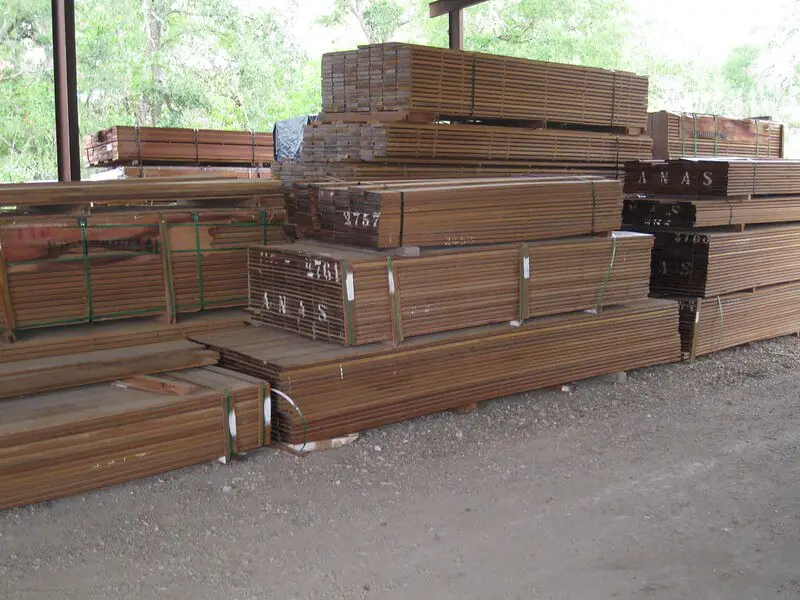Ipe is a tropical hardwood that’s well known for its hardness. With a Janka rating of 3,510lbf, Ipe is more than five times harder than woods such as cedar. It’s also twice as dense as other woods.
Ipe is prized for many reasons. The first reason is its durability, it can last for decades without any treatment.
The wood has high resistance to fungal decay and insect attacks. It has excellent weathering characteristics which makes it the ideal wood for outdoor projects. Lastly, the wood has a beautiful reddish-brown that weathers into a gray patina if the wood is left unfinished.
Read on to learn more about this valuable wood.
What is ipe wood?
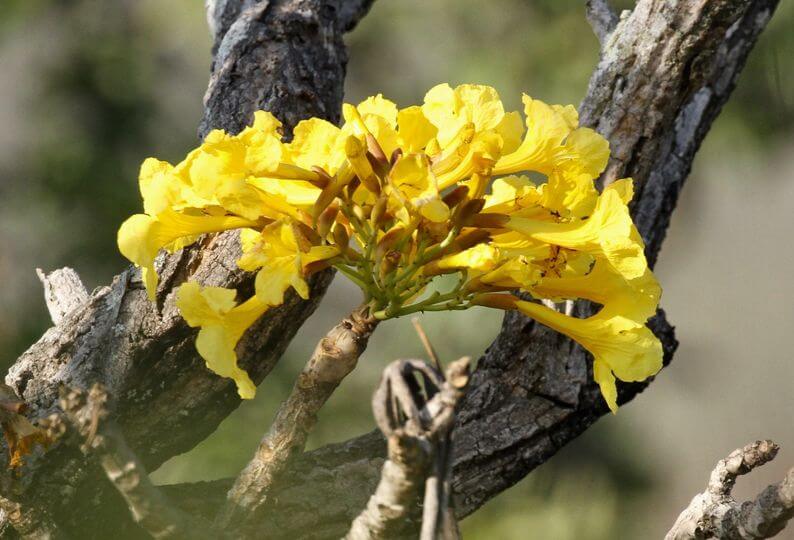
Ipe does not refer to wood sourced from a single tree species. Instead, it represents wood from seven different tree species. The seven trees fall under the genus Tabebuia and sub-genus Lapacho.
Ipe is obtained from tropical hardwood trees that grow up to 130ft tall and up to 4ft wide. The tress can be deciduous, evergreen, or semi-green. They were mainly grown in Brazil but can also be found in Argentina, Bolivia, Guatemala, Mexico, Peru, and Venezuela.
Ipe has several names, including Brazilian Walnut, Poui, Lapacho, and Pau d’ Arco. This wood has grown very popular; for good reasons. Here are some of its characteristics.
Mechanical Properties of Ipe Wood
Here are some of the basic features of Ipe Wood;
| Feature | Score |
| Modulus of rupture | 25,660 lbf/in2 (177.0 MPa) |
| Elasticity modulus | 3,200,000 lbf/in2 (22.07 GPa) |
| Maximum crushing strength | 13,600 lbf/in2 (93.8 MPa) |
| Hardness | 3,510 lbf (15,620 N) |
| Shrinkage percentage | Radial: 5.9%Tangential: 7.2%Volumetric: 12.4%T/R Ratio: 1.2 |
| Wood gravity (at 12% Moisture Content) | .91, 1.10 |
| Average dried weight | 69 lbs/ft3 (1,100 kg/m3) |
| Stability ratio | 8.0 |
Characteristics of Ipe Wood
Here are the properties that make Ipe wood so popular.
Color
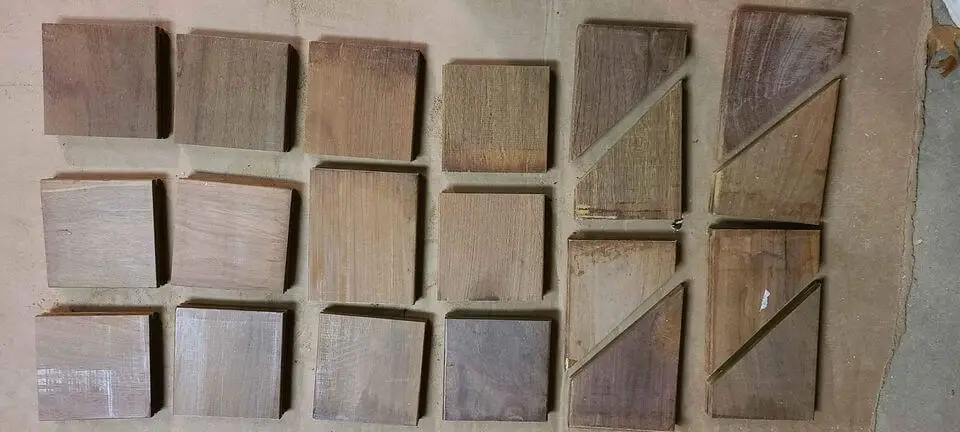
Ipe’s sapwood has yellow tones. The color of the heartwood varies from one tree to the next. Some have a reddish-brown heartwood, while others have a darker blackish-brown color. Some trees even have a yellow powdery deposit within the wood.
Ipe’s color is similar to that of another South American wood called Cumaru. What sets Cumaru apart is its vanilla scent. Ipe has a mild scent and tends to look darker.
Ipe weathers to a light gray-brown color if left untreated.
Grain Pattern
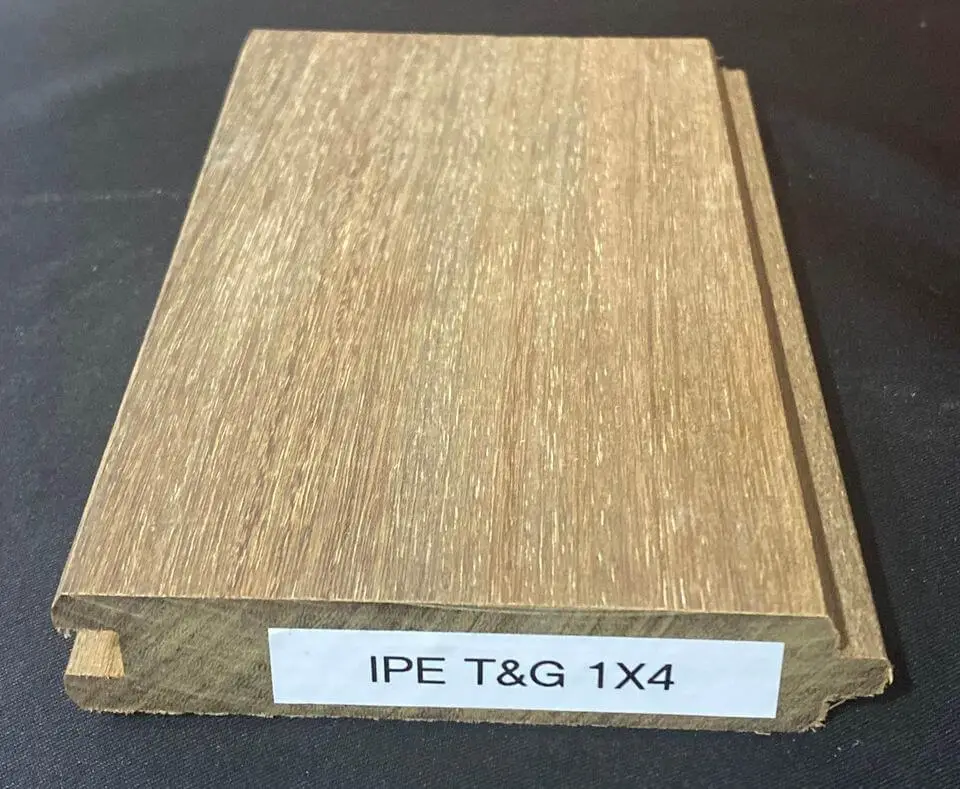
Ipe’s grain pattern varies from straight to interlocked. It has a fine to medium texture and a moderate natural luster.
The end grain of this wood has a diffuse-porous structure. Its pores vary from medium to large and don’t have a specific arrangement. Some species have tyloses and mineral or gum deposits on the surface.
Durability
Ipe is well known for its durability. The wood was used to construct a boardwalk along Coney Island in New York City. The boardwalk is said to have remained intact for 25 years despite the high traffic on the wood. When regularly treated, Ipe can last up to 75 years.
This wood has excellent weathering characteristics. It contains natural oils that make it water resistant. The high concentration of tannic acid in this wood also makes it resistant to fungal decay.
Ipe is very dense, which makes it resistant to insect attacks. However, some of its species are susceptible to marine borers. Additionally, Ipe is a very stable wood with a low tendency of swelling or shrinking.
Ipe wood has a Class A fire rating on the NFPA list. Its fire resistance is similar to that of concrete or steel.
Sustainability
The tropical trees that produce Ipe wood are vulnerable to over-harvesting and illegal logging. Also, Ipe trees grow in very less densities. Mature Ipe trees only occur one per 3-10 hectares in tropical forests. As such, Ipe is less sustainable than other hardwoods such as Oak.
Workability
Most hardwoods have challenging workability, and Ipe is no exception. It’s known to have a blunting effect on cutting edges. This wood doesn’t screw or nail easily. You may have to predrill it before nailing or screwing it.
Ipe has a straight grain and therefore turns well. However, the powdery yellow deposit can make it difficult for you to polish or finish the wood.
Ipe is very dense and also impenetrable. Thus, it doesn’t stain or take paint well. It has a closed grain structure and therefore planes smoothly, but there’s a caveat. Its grain tends to tear out on the interlocked areas.
The high level of natural oils in this wood makes gluing difficult. The only way to get Ipe pieces to glue together well is by preparing the surface before gluing. You can prepare the surface in the following simple steps
- Wipe the wood surface using a solvent.
- Sand the wood to open up the grain.
- Use non-water-based glue.
Allergies
The dust produced by Ipe is linked with skin, eye, and respiratory irritations. Working with this wood can also cause headaches and asthma-like symptoms.
Pricing
Ipe is mainly sold as decking or flooring board. It can cost $23-$30 per square foot.
Certification
Ipe is certified by the Forest Stewardship Council (FSC). This means that this wood comes from forestry operations that meet all the sustainable harvesting procedures. Ipe is not listed in the CITES Appendices or on the IUCN Red List of Threatened Species.
Uses of Ipe Wood
Ipe is mainly used in the following way;
- Outdoor application: Ipe has excellent weathering properties and is used for outdoor projects such as siding, fencing, and furniture making.
- Turned objects: The wood has a straight grain that allows it to turn well. It can be used for making tool handles. Ipe is generally a good wood for turning though it’s a bit expensive.

- Decking: Ipe has all the qualities that make up a good decking material. It’s very hard, durable and resistant to insect attacks. It also has the fire resistance of steel or concrete.
- Interior application: This beautiful wood is also used to make items such as cabinetry, decorative moldings, and floors.
- Siding: Ipe is a low-maintenance wood that can go untreated for over 25 years and still look great. It also holds up to outdoor weather nicely. These two features make it the ideal siding material.
- Construction timber: Ipe is a very strong wood used to construct bridges.
- Medicinal purposes: This wood contains substances such as lapachol and quercetin used in medical drug production. In the past, Taheebo Ipe bark was used for treating several diseases.
Maintenance and Finishing Ipe Wood
Ipe is very durable but that is not to say that the wood doesn’t require maintenance. Here are a few things you can do to extend the lifespan of this wood.
Clean The Wood Regularly.
Sweeping, vacuuming, or cleaning Ipe wood is an essential part of your maintenance routine. It helps get rid of dirt, pollen, or sap that can stain your beautiful deck.
Ensure Timely Repair of Scratches
A scratch on the surface of the sealant allows moisture to seep through which in turn results in the growth of mold. Repairing scratches doesn’t have to be a stressful task. If the crack is minor, sanding the wood and refinishing it will be enough. If the scratch is deep, consider filling it using an epoxy-based filler.
Sealing
A sealant protects the wood from getting scratched. It also keeps the wood looking brand new since it protects it from fading. Here are simple steps you can follow when sealing Ipe wood;
- Start by cleaning the wood’s surface
- If the wood has scratches, consider sanding it using 80-grit sandpaper.
- Apply your sealant.
Tip: If the wood was initially sealed, you must first remove the old sealant using a low-pressure washer. Then allow the wood to completely dry out before sealing it.
When applying the sealant, ensure to use a brush and not a sprayer. A brush will help you achieve a thin, even coating.
Resealing
If you want to significantly extend the lifespan of Ipe wood, consider resealing it after every 12 months.
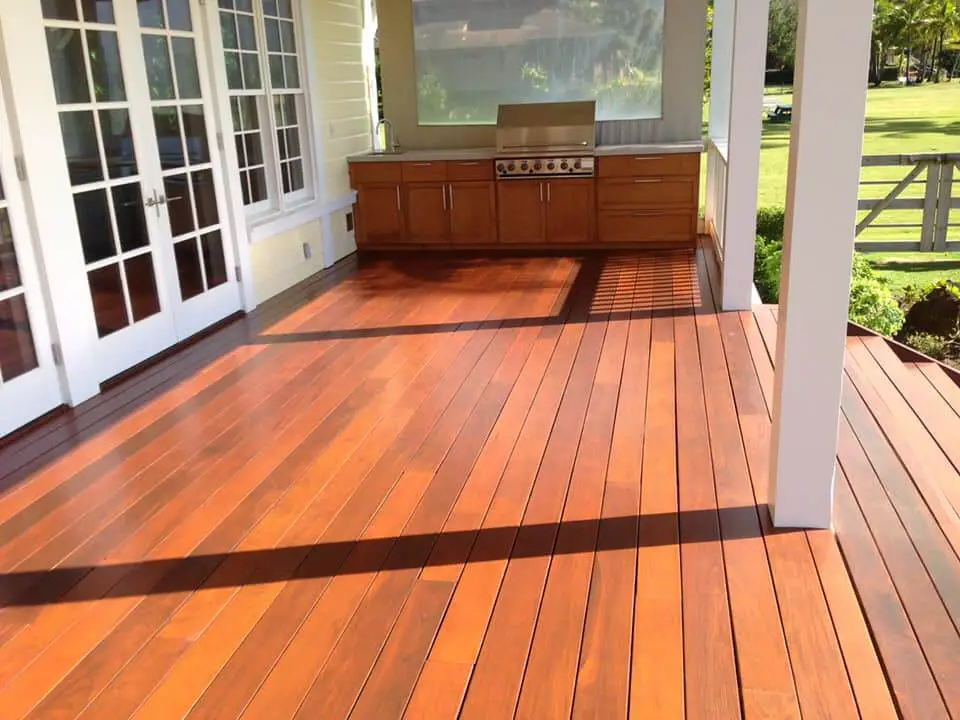
Why is ipe decking so popular?
The popularity of Ipe wood in decking has grown far and wide. Here are the reasons why;
Remarkable Strength
With a Janka rating of 3, 510lbf, Ipe is one of the strongest hardwoods available in the markets today.
Extremely Durable
This wood is extremely durable, it can last for up to 75 years with just minimal maintenance. Its durability can be attributed to its high resistance to moisture, fungal decay, and insect attacks.
Additionally, its fire resistance compares to that of concrete and steel.
Minimal Maintenance Requirements
Ipe is naturally resistant to moisture, fungal decay, and insect infestation. As such, it can withstand outdoor conditions well, even without treatment.
Summary: ipe wood
Ipe wood is obtained from tropical hardwood trees grown in Brazil, Argentina, Bolivia, Guatemala, Mexico, Peru, and Venezuela. It’s also known as Brazilian walnut or Lapacho. This wood is well-known for its durability. Untreated Ipe can last for over 25 years while treated Ipe can last for over 75 years.
Its durability can be attributed to the following properties;
- Excellent weathering characteristics
- High resistance to decay
- High resistance to insect infestation.
- Remarkable fire resistance.
Ipe is an ideal mainly used for decking and siding. It’s also used for indoor applications such as cabinetry and decorative moldings. Additionally, Ipe has a straight grain that makes it ideal for turning.
It has minimal maintenance requirements. The following four activities are enough to keep Ipe looking brand new;
- Regular cleaning
- Timely Repair of Scratches
- Sealing
- Resealing

